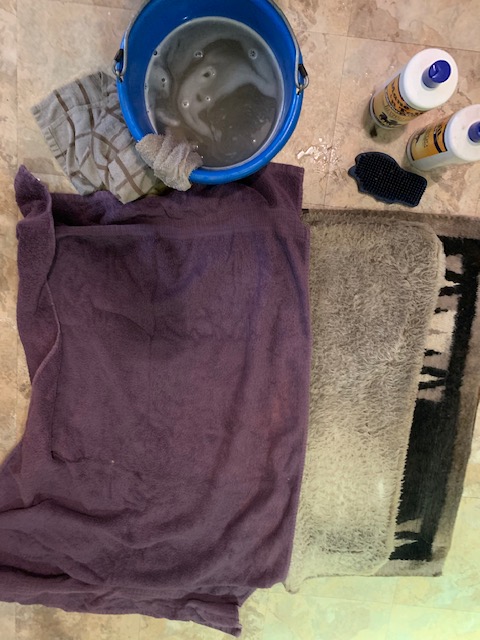I have always preferred wool and felt saddle pads over the neoprene ones, and the same goes for cinches and girths. Yes they are a lot harder to clean, but I find my horses benefit from their comfort level much more.
In the end if I ask myself which I would prefer if I where the horse, I could never say neoprene would be more comfortable. As I see it those kinds of pads really only benefit the riders and not the horse, they are hotter, don’t move with the horse, and pull on the fur and skin.
For a lesson horse, or trail horse being ridden lightly and with a sweat pad between them and the neoprene I don’t see an issue, but for the performance horse ridden 3+ times per week at a high intensity level I would never suggest anyone use anything other than wool or felt.

So, yes they are more difficult to wash, but once you get the routine down pat, and you use this technique your pads will stay clean, and odour free for years to come! This technique will allow you to be using your pad again within 48 hours (most of which is drying time) and only takes about 30 minutes of your time. If you use the traditional technique the pad will take at least twice as long to dry and you cannot clean it during the winter or without a pressure washer.
*Note, no matter how you clean them, if you get a merino wool pad (the fluffy kind) they will always get some kind of discolouration over time. If this bothers you, I would suggest a felt pad instead, they are typically dark gray or black and don’t show the dirt as much. The pad pictured is about 4 years old (used 4-5 times per week most of the time), but once cleaned with the process is soft and odour free despite still being somewhat discoloured.
What You’ll Need

- Horse shampoo and conditioner
- Small bucket of hot water
- 2 large rags and 1 small rag
- A curry comb or stiff bristle brush
- A dirty saddle pad 😉
Prepping and Weekly Care

About once per week or as needed, before tacking I take an undercoat brush and a stiff hoof brush to my pad to remove hair, dust and dried sweat. Make sure that you perform this process before you start washing.
Washing

Adding the shampoo and conditioner to the hot water, not too much as it will be difficult to remove the suds after since we won’t be rinsing the pad per se.
Ring the rags out slightly, so they are sopping wet, but not dripping and lay them over section of the pad. If you have rags that cover all or half of the pad that is best.
Let the rags ‘steam’ for a few minutes, then use them to scrub the pad. You can repeat this process as many times as needed
Once you have the majority of the surface dirt off and the pad is damp proceed to the next step.
Deep Cleaning

Take a small amount of shampoo in your hands, rub them together and lightly spread the shampoo all over the underside of the pad. Take your curry comb or stiff bristle brush (dipping it in the hot water as needed) and scrub away to get at the dirt that has gone deeper into the pad.
Rinsing

To rinse the pad you will repeat the washing process above, but using fresh clear water, rinsing the rags as you go to remove any left over shampoo.
If the pad has dust on the outside as well, you can scrub it with just water, or do the same washing process to remove tougher stains.
Drying
Place a large dry towel inside the pad, and fold it over, pressing to remove the excess water.
Combing and Fluffing

To finish up, while the pad is still wet go over it with a shedding tool (Furminators work best!), this will remove any hair you could not get at earlier because it was too entangled in the fibres of the pad.
Finishing Up
Let the pad dry for a few hours, or overnight and you are ready to ride!
Extra Deodorization

If your pad went a long time without being washed, or it just happens to be a little funkier smelling, once dried you can sprinkle a generous amount of baking soda all over the pad, let it sit for 24 hours, scrub with a stiff bristle brush and vacuum away! Any lingering smell will be taken care of after that!
Yes this process takes some of your time, I would suggest repeating it 2-4 times per year. But in the long run your horse will be better off overall. I also find that these kinds of pad are a lot more comfortable for us, if you swap back and forth you can tell the cushioning effect actually helps absorb more of the shock. Which is good news for both you and your horse! 😀

